| |
| |
| -- 3rd to 14th October 2011 -- |
| |
|
The shortest trips are not always the easiest... but they make us enjoy longer even studious stays at the pontoon all the more!
Few pictures of our work-time (and lots more of our play-time) on our page "Photos".
|
|
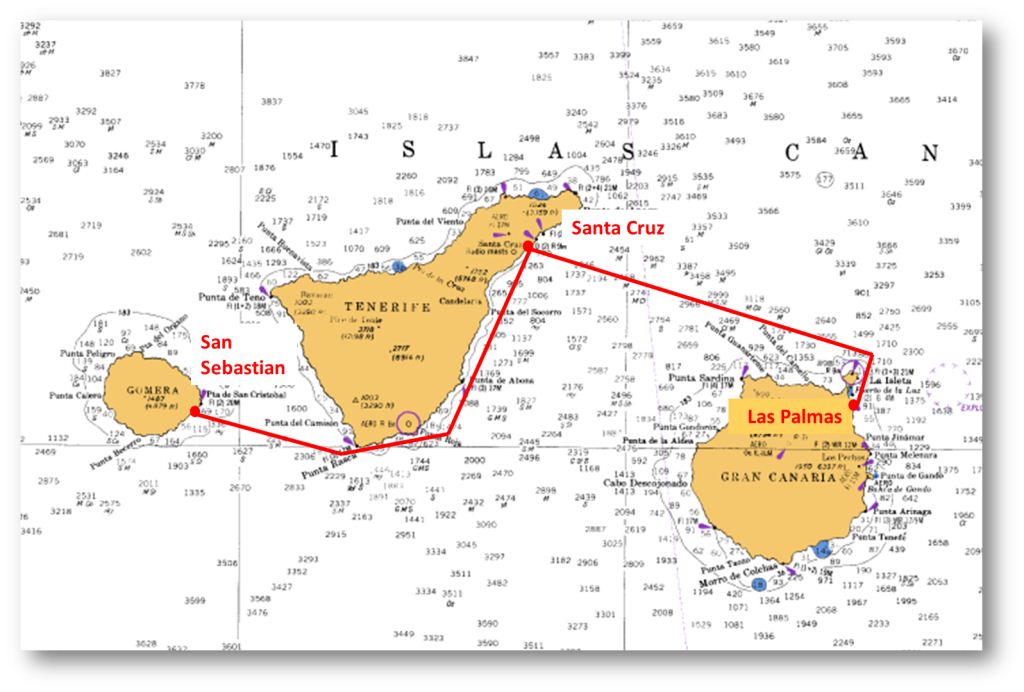
Sailed 124 miles
3197 miles since the start
|
|
|
|
| |
|
3rd October : Las Palmas – Santa Cruz de Tenerife (56 miles)
|
|
You remembered we stopped in Las Palmas to wait for the wind to pick up and save some hard work for Nestor right? Well, after two days in this ugly city, the conditions seem to be better again – ideal even: 15 knots from North East they say! We leave in the early morning, the course happily set to Santa Cruz – for a trip which turned out to be the worst we had so far.
The way out of the harbor is a giant slalom between ferries, cargo ships, fishermen... they really have from everything there, even an oil-platform getting towed out to a brighter future. It would be almost funny to try and avoid all that mess, if that was not real life, with no extra life after the “game over” screen. And while we’re maneuvering our way out we have to admit another painful reality: there is no wind at all. Good Old Nestor starts an early 3 hours shift.
Keeping an eye out for any riddle on the water, we try and hoist the spinnaker in a feeble breeze. In a minute it becomes a good breeze: we run at 6.5 knots as soon as the sail is out of its cover. That’s one good hour more. Then the wind dies as suddenly as it started, it must have been some local effect at the Northern end of Gran Canaria. As she is taking the spi down, Laure loses her sun-hat in the water. On the way to save this precious accessory from the water, what had to happen happened: we crossed our fishing line, the nylon line got stuck in the propeller. No wind, no engine: no choice we have to get in there and cut everything to free up the propeller. Laure takes the dive, a safety rope around her waist and a knife in her hand. No easy to work on a boat with that swell! In the end it takes a good half hour, some hundreds swearwords and a small cut to the finger (soon cicatrized) to clean everything. And don’t worry: the hat is safe :o)
So here we go again, engine on in no wind, when a light breeze is getting up... from the West!! Blowing right to our face that is! We have two options: keeping the engine on making a direct route but slowed down by the wind – or sailing close to the wind, tacking as required even more slowly. For Nestor´s sake we try the sails and turn it out. Just then, we realize that there is no power coming to the engine starter any more: no way to turn it on again! Great... and of course our small meter (the tool you use to measure tensions and resistance in a circuit) decides it’s the best moment to go out, making the reparation even more... interesting. Good that Camille had kept her car cables she used to jump start her little 205: thanks to them we can short-circuit everything and bring the power where it´s needed to start Nestor again.
Letting him rest is out of question now. Progressing at 3 knots in a dying wind and annoying speed-breaking swell we enjoy a nice sunset on the island nonetheless.
|
|

Arriving to Tenerife, the Mount Teide is on the left, the Anaga Mountains on the right ; and Santa Cruz straight ahead!
|
|
|
We enter the harbor around 11pm. The guard on duty shows us our berth: “there, next to the other small French boat”. Small boat? With a blue sail cover and a Navik wind pilot? But.. that´s Ster Vraz! Out of chance we´re mooring just next to our buddies: that´s the one good news of the day saving it all! Rarely have we been so relieved to arrive somewhere...
|
|
| |
|
From the 4th to the 12th October – Santa Cruz de Tenerife (ashore)
|
|
We stop at the Marina de Santa Cruz, formerly known as Marina del Atlantico. The harbor is of human size (nothing in common with Las Palmas) and has a fair amount of free spots to offer (at least when we were there). The crew is rather friendly, the showers are very clean and there is even a self-service launderette at reasonable price! No internet though, you have to look for some in town, at the usual suspects (Mc Donalds and other bars and pubs). The harbor is well sheltered. It doesn’t have a tariff for us “pequenitos” (less than 12m) unfortunately and we pay 18 euros/night.
Santa Cruz is a smallish town rather nice and pretty, with a market, shipshandlers, “real people” (i.e. in a suit and tie speaking Spanish on the phone, not in a bikini screaming in German) in the street, a beach not too far... well again much nicer than Las Palmas – at it seems at first looks at least!
|

Some tree in Santa Cruz : when the liana reach the ground they turn into new truncs
|
|
What attracts us to the island is its summit as well: the mount Teide is the highest point in all Spain, towering at 3718m.
Tenerife is also the last stop where we can have bigger work done on the boat before... Trinidad, on the other side!
That´s why we divide our time there between work – and leisure.
Working:
First things first: Good Old Nestor has the honor of being dealt with as high priority. Good news: there does not seem to be any line left around the propeller. Other good news: we find the origin of the electrical problem: a rusty cable just broke. We have the right connections onboard to replace it and a few hours later everything is in order again. That´s worth celebrating with Ster Vraz (until late in the night...)
|
|
|
On the second day starts the Saga of the Sacred Ring. The Teflon ring holding the tiller in place is partially worn out and the tiller moves a bit too freely, making more and more noises since Madeira. We decide to replace this part, which can be done without taking the boat out of the water. Taking the tiller off is quite easy –especially with the expert help of Julien from SterVraz (who had just performed the same operation on his boat a few days before). Getting the old ring out is another kettle of fish – in the end we have to saw it.
|
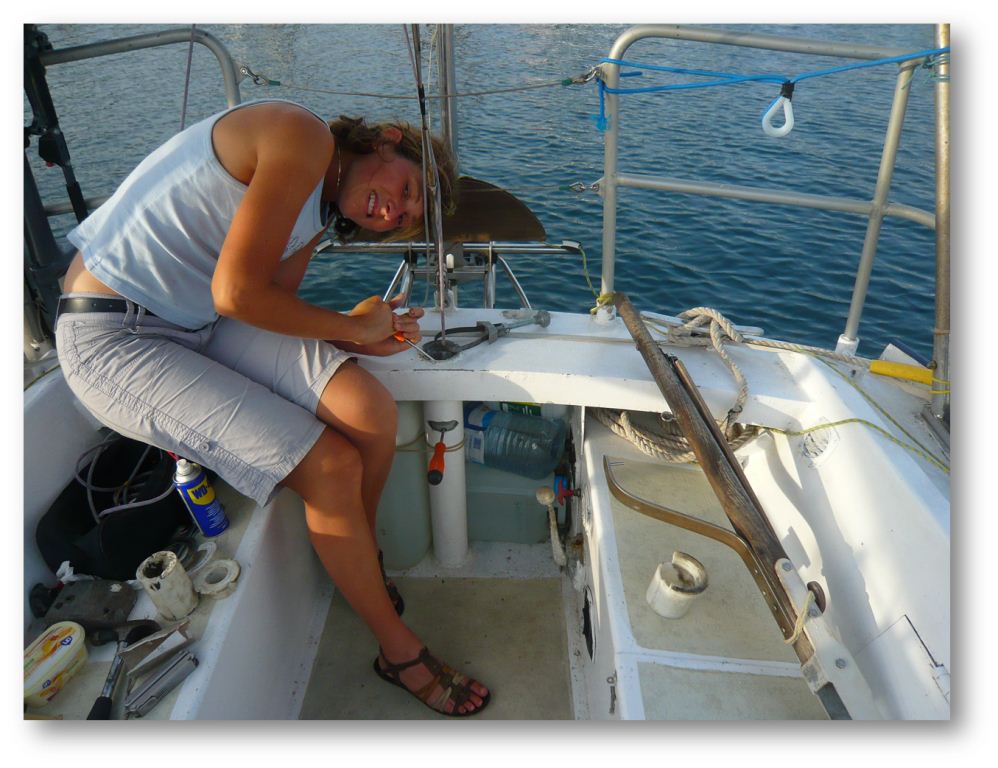
The tiller is out, the rudder blade secured with a piece of string and a screwdriver, the old ring has been sawed out and Laure is sanding the tube.
|
|
|
We next visit the fishing harbor, 10 minutes away in “guagua” (=bus). There we find a workshop to make a new ring within a few hours! Unfortunately the new ring is too large on the external side and gets stuck. Super Julien saves us again, getting it out with a hammer. Back to the workshop, they say it´s our fault for not hammering it in strong enough (we are women, thus weak creatures). They will not sand down the exterior of the ring, only a bit the inside... so we try again – and it stays stuck again. This time for good! Even Julien with his hammer and Mathieu (from Taoz) can´t help us this time. We are growing discouraged and a nice night onboard of Taoz (a Britton couple from Geneva with their two sons) lifts our spirits a bit.
|
|

The solution was obvious !
|
The next day is a national holiday, no workshop open of course. A piece of luck though: on the next pontoon, the Norwegian Ovni 395 called Frida has exactly the tool we need! It´s called an “extractor” and is used to extract propeller e.g. What a great invention! Despite its small size it gets the damn ring out in no time!! (with the additional help of one book, one dictionary, a cutting board, the used ring of our neighbors, a winch strong steel winch handle and an English key only).
Bliss... Four times the ring will be tried in, then extracted again to be manually sanded down to the exact size. A whole afternoon of work later our tiller is back in place and firmly held, yet smooth to handle: perfect! And we are exhausted.
|
|
|
Another chore: counting the stocks and cleaning the food cans. Would have been simple, had rust not taken such a good bite at some of the tincans (all fruit). Sticky juice all around is a the best way to get some crawling 6-legged company as you know since our last article. We have no cockroach onboard yet and wish to keep it that way as long as possible. As a matter of precaution we make some special little balls with flour, concentrated milk and boric acid (kills them).
|

Anticockroach bitterballs recipe: flour + concentrated milk + boric acid
|
|
But don´t worry we still enjoy ourselves – and the company of our favorite neighbors SterVraz, always onboard of the one or the other boat for diners or drinks. Or charts exchange: this is a very decent activity, involving the stock of charts of one boat being compared with that of the next boat – and a copy machine filling the gaps for 1.9 euros / chart!
Last but not least, our computer is showing some reluctance to go on the internet. Obvious lack of cooperation when the homepage of your favorite website takes more than one minute to open! Yet still unexplained, as the antivirus could find nothing and the usual tricks were performed to empty and refresh and defragment and everything. A laptop is critical, not only to write those lines (and yes yes we know it´s vital!), but also to receive the weather forecast and look at the charts we don´t have in paper versions. No tax makes everything cheaper in the Canarias, in the end we give up and buy a small cheap laptop which will be the only one exposed to the internet... ¡with a Spañish keyboard!! :-S (you were right Bro´, one laptop only was not enough...)
Exploring the island:
We take ourselves a 3-day weekend off from the working week and rent a car to explore the island. First stop is of course the Teide National Park! On the way there the road winds on the ridge quickly climbing up to 1500m. after crossing a newly reforested pine area we reach the 17km wide old crater making up the center of the island (called “las Cañadas”.
|
|
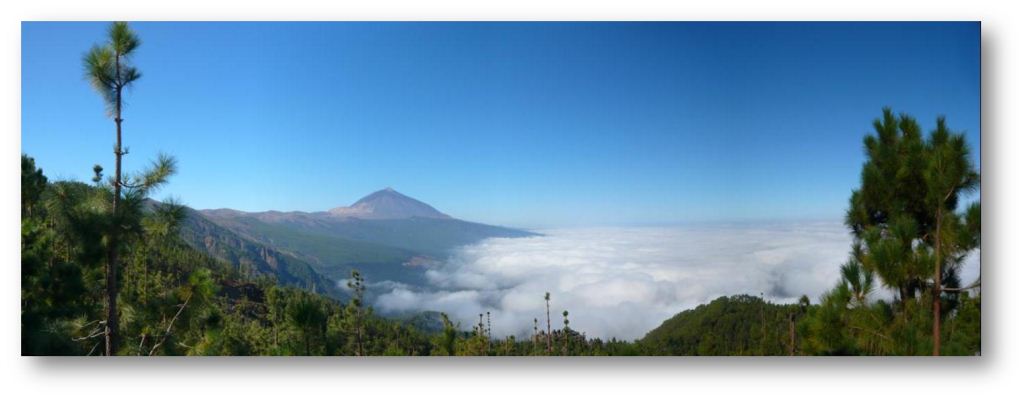
Looking at the Mount Teide from the pine forest
|
|
|
Up to 1800m, the landscape changes radically! Not a single tree to be seen, only lowbushes green and yellow on a red dry soil background. We walk around in those colorful settings...
|
|
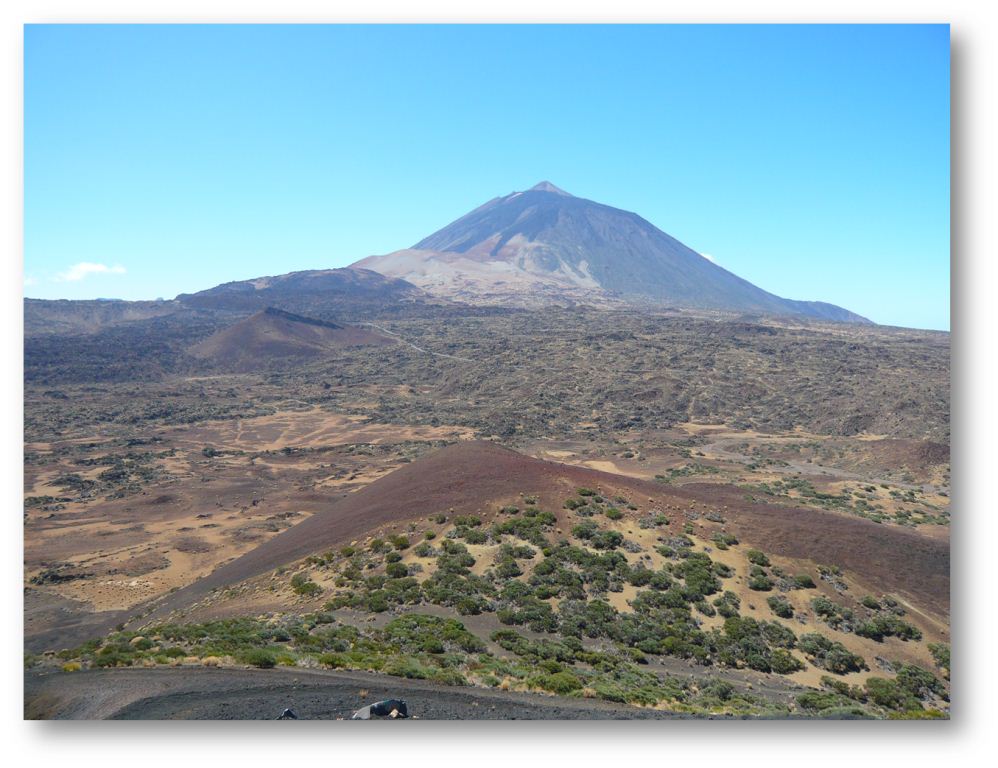
The Teide – there´s no avoiding the sight
|

This used to be on the 1000 pesetas bill.
|
|
We park the car at 2200m and begin to climb. On that first day up our goal is the Altavista shelter, 3200m high. There you can spend the night and save the last 500m for the next morning, to reach the very summit before dawn and watch the sun rise from there. You have to book in advance though, by tel or in the Santa Cruz office. The shelter is equipped with cooking equipment, but no shower – and no drinkable water!
So up we go, at a leisurely pace first on a wide flattish path through white and pink sands, and big black egg-shaped balls. Those are like snowballs, only from lava: they were formed by aggregating lava rolling down the volcano slopes. The second part of the hike is a lot steeper. We reach the shelter a while before the sunset, and that´s good because it’s starting to be chilly out there: 5 deg is no ideal temperature for a romantic promenade in the sunset!
|
|

Walking up to the peak : behind us the cloud-sea
|

That´s a lava-ball field !
|
|
|
The shelter is full of tourists, mostly Spanish - hence loud and talkative. There are warm blankets on the beds and if it were not for the lack of oxygen in the overcrowded dorms we would have slept very well.
|
|

The Teide’s shadow seen from the top
|
It’s an early start on the next day : 6h15, with headlights on (first hike in the dark ever for us). 1h30 later there comes the reward to all our efforts: we are standing at the highest point of Spain, 3718m high precisely! And the show begins: the sky is turning bright red and pink and orange in the East, the rocks absorbing the colored light and standing out of the darker background. Gran Canaria in the distance looks like an island floating in the sky. As the sun actually emerges (unfortunately heat doesn’t travel at speed light, it’s still about 2 deg up there!), the view to the western side becomes stunning: the islands of La Palma, La Gomera and El Hierro are very clear. And standing between them, a huge triangular shadow: the Teide itself!
|
|
No time to linger around though, we have to be back down at the gondola platform before 9am. At this time the official visits start, for which you have to book a permit (weeks in advance) on the internet. People from the shelter are somehow exempted – anyways they’re up there way before the guards.
On the way down we take a little walk towards the Pico Viejo (most recent crater, erupted back in 1798).
|

The Pico Viejo its so-called « nostrills », the last lava flow is clearly visible on the right side
|
|
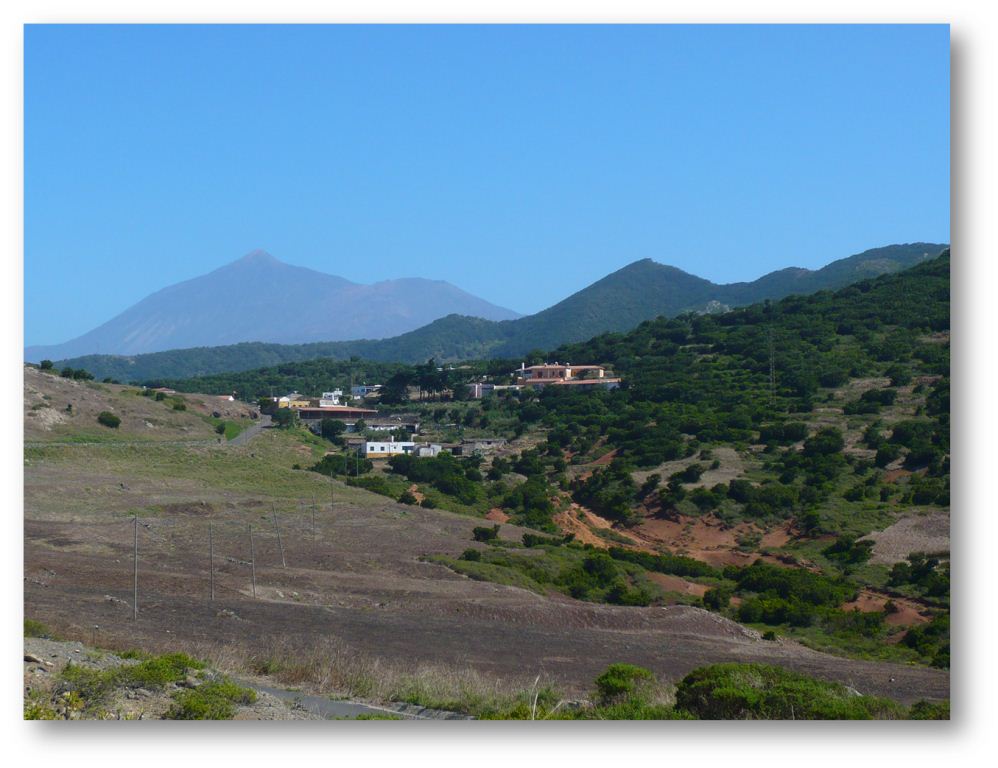
There is some green stuff on the Northern slopes, where the clouds stay stuck to the summits
|
From the exit of the Park we drive to the West, towards the older-but-as-volcanic Teno mountains. Everything is lower here (only 1500m!) but little villages nesting in deep canyons are stunning nonetheless.
|
|
|
Further North Garachico is a very pleasant little seaside town, old touristic style. Quiet and full of light. Rocks make up “natural swimming pools” – actually closer to waves pools completely open to the swell brutally engaging in the narrow corridor. Of course Laure finds it very funny!
|

Natural waves pool : the swell coming in is impressive
|
|

Church in La Orotava
|
We drive on to the Orotava, an beautiful historical town, full of elegant old buildings. It is calm, very calm actually on that Sunday night – so calm no restaurant is open and we have to drive down to the tourists hive of Puerto de la Cruz. Bad idea. Not sure what is more aggressive to us, the loud German crowds or the bar tenders standing at the door shouting at you to get you in. Have we become salvages somehow, allergic to civilization? Trying to hide from that noise in the patio of a “typical” but disappointing restaurant.
|
|
|
The next day we go and hike in the Northern mountains of the Anaga. Yet another type of landscape, it looks almost like the terrace-fields from Madeira, only everything drier, steeper and fuller of cactus! There are a lot of laurel trees as well and other bushes which form what is claimed to have been the original Mediterranean forest before the last glaciation period. At the very end of the park we hike down to a black sand beach. Two houses standing there, no one in sight. It’s hot and we are dying for a swim, but we have forgotten our suits and towels... hey, what the heck, there´s no one anyways and if the sand is burning our feet you can imagine how quickly we dry. On the way back we pass by a lighthouse and around a peak inhabited mainly by goats :o)
|

Our private beach...
|
|
Last mission of the day as long as we got a car: shopping! The Spanish version of the French hypermarket chain called “Auchan” has been literally translated into “Al Campo” – and kept us busy for more than three hours, so huge it was.
All in all we loved the island because its landscape is so diverse. Yet we didn’t meet so many locals nor tried enough local dishes. Tenerife is really oriented towards tourism.
Bonus track by Laure – first kitesurf lesson :
|
|

Full gear. Note the helmet, like a cool « talk to the aliens » headset.
|
Everybody will tell you the Canarias are a paradise for wind- / kite- / anything-gliding-on-the-water-surfers. I have been wanting to try it out for a long time, dreaming about those big kites that make you fly above the waves... hop, today is the day! The wind is always strong on El Medano beach, always gusts from the sea. Perfect to learn they say: if you can do it there you can do it anywhere. Twice 90 minutes with a very short lunch break in-between, I have no time to get bored and find myself suddenly disguised into a wetsuit alien equipped with an antenna on the cask and a kite in my hands. The teacher is giving instructions through the radio, like a voice in my head: “Asi es, muy bien, mas altura...” (they had only Spanish teachers left... well doesn’t matter I don’t say anything anyways and when the kite hits the ground it means I did something wrong!). I did not get as far as putting the feet on the board actually, but already got my share of salt water in the face and enough sensations of power and speed to get me hooked!! Can’t wait for the next lesson in the Cape Verdes!
|
|
| |
| TOP
|
| |
| |
|
13th -14th October: Santa-Cruz – San Sebastian de la Gomera (68 miles)
|
|
Our work on the boat is completed, we are invited to a goodbye coffee by SterVraz before sailing away to new adventures! More precisely to the West, the island of La Gomera.
The trip begins by an emergency repair of a blocked winch (luckily easy to unscrew and grease and screw back in the middle of the outside harbour). It’s 7 pm when we hit the road for good, in 15 knots from the back, only the genoa up.
We chose to turn Tenerife by the South. The Imray warns us against a zone where wind accelerated between the islands by a Venturi effect can become twice as strong on the Eastern coast. We keep a very cautious eye thus, taking in more sail as the wind indeed gradually picks up. The acceleration is real but progressive and from the back, no surprise there. The sea is nasty though, short swell with higher and higher waves, some of which breaking on the backboard. We’re surprised by how well Saltimbanque is doing there, surfing on the wave crests and no taking any water in. Right after at the Southern Point the wind suddenly falls from 25 to... 5 knots!
On the South-West side of Tenerife we are sheltered from the usual Northeasterly trade winds and have to turn the engine on for more than 4 hours. Nestor makes us worry a bit as it´s losing power. Probably bacteria in the diesel... Nestor is suffering under 3 knots... poor Nestor...
(PS : personal note to the BP colleagues : the diesel we suspect comes from the Lisbon BP station ! Really, those biofuels, what a crap ;-) well, sure the storing conditions onboard in plastic cans in a humid environment do not fulfill the HSSE checklist... but I don’t care, I’ll still put in lots of bactericide, curative AND preventive treatment!).
|
|
|
Good thing about being slow is that the sun gets up when we’re still 8 miles away from La Gomera. There is said to be another strong wind acceleration on that side as well. And indeed, we can see the sea whiter with foam in the distance. Real quick we take in two reefs and roll a bit of the genoa. Engine off. Pfewww in 30 seconds the wind picks up from 5 to 30 knots, with gusts above the 35! And it veers Northwesterly too: we can’t sail directly to the harbour and have to tack again. The mainsail is completely down now, we are trying to make the best course with a rolled genoa only. The swell is short and choppy again. First time we take so much wind with Saltimbanque: he impresses us again, keeping stable and close to the wind. Good boat :o)
|

Cones are not always meant to relax you... here the acceleration zones we crossed during that trip.
|
|
A few hours struggling in a sloppy wet world later we enter in the San Sebastian harbour. The wind is as strong up to the inside of the harbor itself but Nestor gets us in. Good Nestor. Yet he’s playing again the same trick as in Brighton: the alarm goes on while all the levels are good – probably some bigger wave short-circuited the loudspeaker again.
In the end a (long) night at sea is ending in the charming little harbor of San Sebastian. We are invited to berth at the pontoon G, special for little cute boats. Saltimbanque is happy amongst his peers – and our wallet too: 11 euros/ night only. The wind is increasing again in the afternoon – but that won´t keep us from enjoying a nice siesta!
|
|
| |
| TOP
|
| |
| |
|
|
|
|
